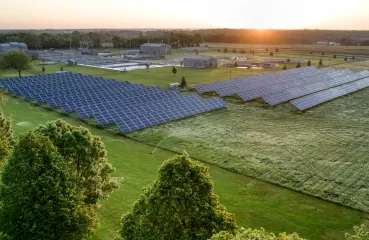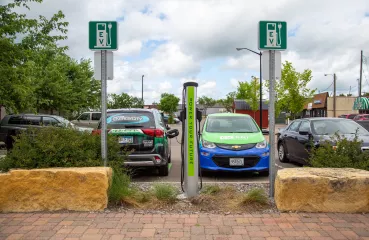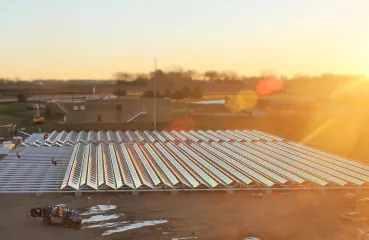Lissa Pawlisch: Brian, remind us again what the Minnesota Solar Toolkit is all about?
Brian Ross: The Minnesota Solar Toolkit is about providing guidance for local governments to be “solar ready.” As the solar industry and solar development pressure ramps up, how do communities and local governments who represent those communities get ready for solar development in ways that enable property owners to be able to take advantage of their solar resources, capture valuable local solar reserves, enable communities to reach energy (or climate) goals they may have, and to ensure that all development fits into the local context. This toolkit provides a pathway through which local governments can help solar development be consistent with community priorities.
Lissa: Who should use this toolkit?
Brian: The toolkit is written for local governments, as the shepherds of development within the community. But there are other audiences as well, including other community stakeholders who have concerns about best practices and how things work across jurisdictions as well as the solar development community itself who can then better understand the community perspective and their expectations. We want the development process to be transparent and predictable. People on both sides of the permit counter should know what the expectations are and the standards they will be held to.
Lissa: What are the most important updates you made to this version?
Brian: The most significant update is the model ordinance itself. It’s evolving quickly as new circumstances come up at the community level. We’ve been periodically going in and updating that. Of course, as we do that we’ve made some other changes, but we haven’t updated everything yet—like the permitting pieces. We did, though, update some of the language about policies, because those too have changed, as well the overall characterization of the Minnesota solar market. We have four times more solar than we did when we first wrote the toolkit!
The principles sections, for comprehensive planning and zoning, have largely stayed the same, though some elements have become more important as the industry evolves.
Lissa: Say more about what you’re seeing now as more important as the industry is evolving?
Brian: Minnesota has seen most of the solar development—over half—in the form of community scale development. This is unique in the nation. Nowhere else do you see 800 megawatts worth of principle use solar development on the 5 megawatt or less scale, and purchased directly by retail customers. We are behind the national curve on the distributed (rooftop) scale. And we are now starting to see increased pressure for utility scale work. Although we have such transmission interconnection congestion utility scale development can be problematic in the short term. In the Midwest overall, we’re seeing a rapidly accelerating industry and dramatic increases in the number of utilities that are emphasizing renewables in their resource plans. And this is changing the development pressure that communities face, and on how they address solar deployment and become solar ready.
Lissa: Are there a couple of elements of the model that you think are really important to stress?
Brian: The model ordinance part of the Toolkit probably has the most impact and is the one for which local government find themselves wanting best practices. We have really beefed up the principal use solar section of the ordinance to address issues rising to the forefront at community scale. Everything we added are responses to local issues that have come up in actual deployment cases.
We are also trying to point the way to help communities create opportunities for co-benefits from this development. At GPI—and for CERTs—how to create this co-benefits approach to solar development is a focus. For large scale development in particular, there are both risks and benefits to the local community—as there are with any development. If we recognize that there are local impacts—including benefits—then it can facilitate effective development. We want communities to see how they have control over how the co-benefits flow to their communities. For example, through solar, how do you protect water quality - surface water, groundwater, drinking water? How do you create habitat? How do you enhance or at least mitigate for visual impacts of these development forms? Are there ways to use this development to help protect your rural landscape and options? How do you help agriculture? These are issues communities talk about all the time. There are ways that you can do solar development that enhances these things. Solar is a high demand development opportunity and that means there are opportunities for you to get benefit from it.
Lissa: Are there any themes from what you see in terms of local rules that cause you concern? If so, why?
Brian: Yes. Because solar is a new form of land use in many communities, they don’t know what the best practices are or what the risks are to solar development. And, in some cases, solar is jarring to folks in a landscape where they don’t expect it. We saw this with wind, too. The same sort of things happened with wind, and it can be a generational thing. Maybe for people for people my age, maybe we didn’t expect to see wind and solar. For my kids, they think this is part of the rural landscape.
One of the things we emphasize in the model ordinance is that standards and requirements shouldn’t be singling out solar for regulation on things like visual impact or even impacts to natural resources or farm land that the community is not also applying to other forms of development. Of course, it’s a legitimate thing for a community to say, “how do we manage this valuable natural resource in our community that contributes to our economic base?” but we shouldn’t be singling out one land use, we should be focused on the bigger picture. We have seen communities place screening requirements or setback standards on solar development that are far in excess of anything else in their standards or ordinances.
Lissa: Are there some jurisdictions in Minnesota who you feel are really getting it right?
Brian: Well, we always have to talk about Stearns County, of course. They were the Midwestern one of the national leaders on addressing co-benefits. They said we see pollinator habit as a real asset to the community that we can see through solar development, and we can also see a water quality benefit. And they required to developers that they do pollinator habitat but then they mitigated the regulatory risk by saying these would not count solar as an impervious surface as per our storm water ordinance. There was both a give and a take that they did that recognized the co-benefits.
The other thing that they did, is that they engaged stakeholders in a meaningful and deliberative way as questions and concerns have come up. As a result, they were able to do a good job integrating the solar development into the rest of their ordinance structure. For example, if you are going to do pollinators, what about noxious weeds? Good question. Stearns County has a noxious weed ordinance; we will regulate in the same way. They already had a screening ordinance. They didn’t need a whole new standard for solar. They just needed to apply the existing ordinance to solar. That’s the kind of integration that’s important.
Other counties have also done good things. Winona recognized they needed to be consistent around farm land issues, but wanted to encourage solar and had to work deliberately to match those two things up.




